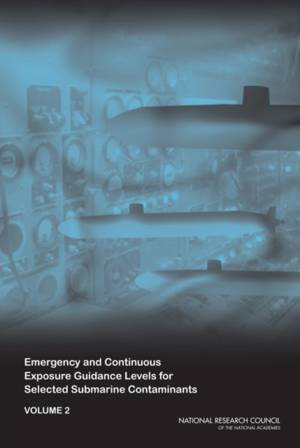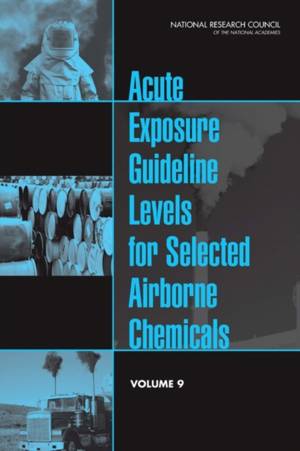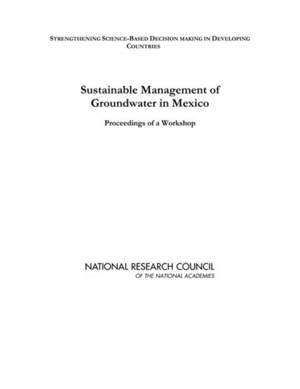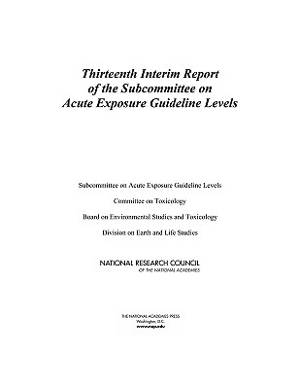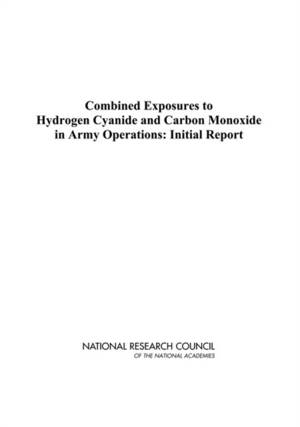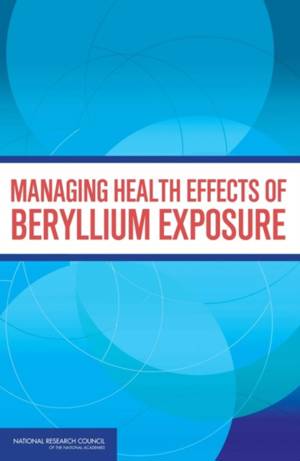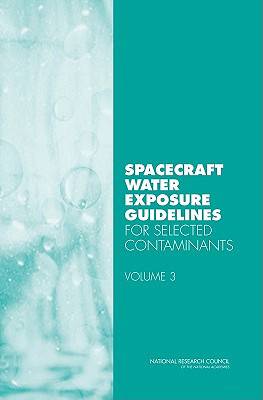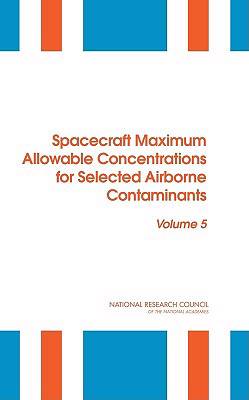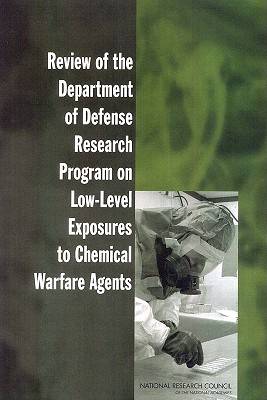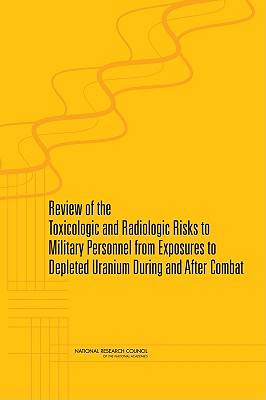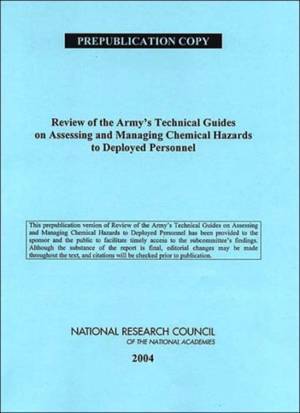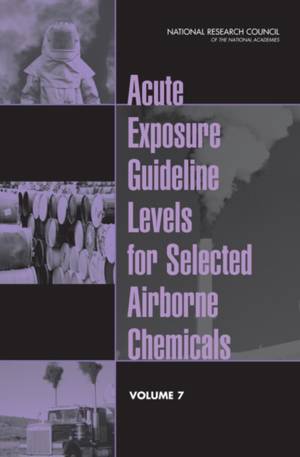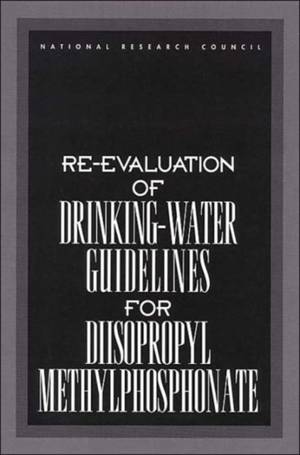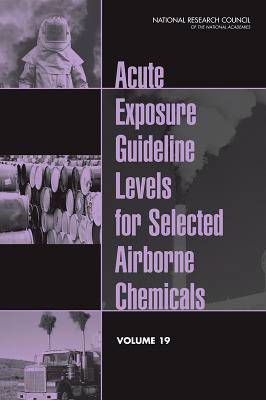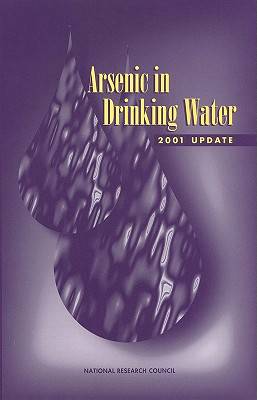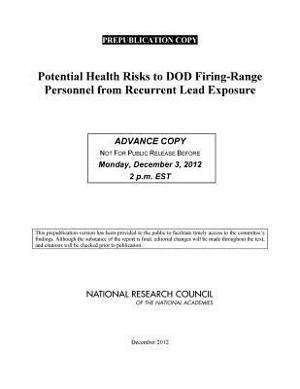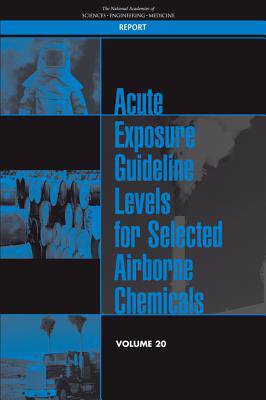
- Retrait gratuit dans votre magasin Club
- 7.000.000 titres dans notre catalogue
- Payer en toute sécurité
- Toujours un magasin près de chez vous
- Retrait gratuit dans votre magasin Club
- 7.000.0000 titres dans notre catalogue
- Payer en toute sécurité
- Toujours un magasin près de chez vous
Résultats pour "Committee on Toxicology"
-
Emergency and Continuous Exposure Guidance Levels for Selected Submarine Contaminants
National Research Council, Division on Earth and Life Studies, Board on Environmental Studies and Toxicology, Committee on Toxicology, Committee on Emergency and Continuous Exposure Guidance Levels f
- Livre broché | Anglais
- U.S. Navy personnel who work on submarines are in an enclosed and isolated environment for days or weeks at a time when at sea. To protect workers fro... Savoir plus
103,45 €Livraison sous 1 à 4 semaines103,45 €Livraison sous 1 à 4 semaines -
Acute Exposure Guideline Levels for Selected Airborne Chemicals
National Research Council, Division on Earth and Life Studies, Board on Environmental Studies and Toxicology, Committee on Toxicology, Committee on Acute Exposure Guideline Levels
- Livre broché | Anglais
- Acute Exposure Guideline Levels for Selected Airborne Chemicals, Volume 15 identifies, reviews, and interprets relevant toxicologic and other scientif... Savoir plus
62,95 €Livraison sous 1 à 4 semaines62,95 €Livraison sous 1 à 4 semaines -
Toxicologic Assessment of Jet-Propulsion Fuel 8
National Research Council, Division on Earth and Life Studies, Board on Environmental Studies and Toxicology, Committee on Toxicology, Subcommittee on Jet-Propulsion Fuel 8
- Livre broché | Anglais
- This report provides a critical review of toxicologic, epidemiologic, and other relevant data on jet-propulsion fuel 8, a type of fuel in wide use by ... Savoir plus
62,95 €Livraison 1 à 2 semaines62,95 €Livraison 1 à 2 semaines -
Spacecraft Water Exposure Guidelines for Selected Contaminants
National Research Council, Division on Earth and Life Studies, Board on Environmental Studies and Toxicology, Committee on Toxicology, Committee on Spacecraft Exposure Guidelines
- Livre broché | Anglais
- The International Space Station is a closed and complex environment, so some contamination of its internal atmosphere and water system is expected. To... Savoir plus
156,45 €Livraison sous 1 à 4 semaines156,45 €Livraison sous 1 à 4 semaines -
Acute Exposure Guideline Levels for Selected Airborne Chemicals
National Research Council, Division on Earth and Life Studies, Board on Environmental Studies and Toxicology, Committee on Toxicology, Committee on Acute Exposure Guideline Levels
- Livre broché | Anglais
- This book is the ninth volume in the series Acute Exposure Guideline Levels for Selected Airborne Chemicals , and reviews AEGLs for bromine, ethylene ... Savoir plus
102,45 €Livraison 1 à 2 semaines102,45 €Livraison 1 à 2 semaines -
Acute Exposure Guideline Levels for Selected Airborne Chemicals
National Research Council, Division on Earth and Life Studies, Board on Environmental Studies and Toxicology, Committee on Toxicology, Committee on Acute Exposure Guideline Levels
- Livre broché | Anglais
- In 1993, the National Research Council's Committee on Toxicology developed criteria and methods for EPA and the Agency for Toxic Substances and Diseas... Savoir plus
57,45 €Livraison 1 à 2 semaines57,45 €Livraison 1 à 2 semaines -
Thirteenth Interim Report of the Subcommittee on Acute Exposure Guideline Levels
National Research Council, Division on Earth and Life Studies, Board on Environmental Studies and Toxicology, Committee on Toxicology, Subcommittee on Acute Exposure Guideline Levels
- Livre broché | Anglais
- Formed in 1995 by EPA, several other federal and state agencies, and several private organizations, the National Advisory Committee on Acute Exposure ... Savoir plus
15,45 €Livraison 1 à 2 semaines15,45 €Livraison 1 à 2 semaines -
Combined Exposures to Hydrogen Cyanide and Carbon Monoxide in Army Operations
National Research Council, Division on Earth and Life Studies, Board on Environmental Studies and Toxicology, Committee on Toxicology, Committee on Combined Exposures to Hydrogen Cyanide and Carbon M
- Livre broché | Anglais
- In response to a request from the U.S. Army, a committee convened by the National Research Council (NRC) conducted the first in a sequence of studies ... Savoir plus
18,45 €Livraison 1 à 2 semaines18,45 €Livraison 1 à 2 semaines -
Standing Operating Procedures for Developing Acute Exposure Guideline Levels for Hazardous Chemicals
National Research Council, Commission on Life Sciences, Board on Environmental Studies and Toxicology, Committee on Toxicology, Subcommittee on Acute Exposure Guideline Levels
- Livre broché | Anglais
- Standing Operating Procedures for Developing Acute Exposure Guideline Levels for Hazardous Chemicals contains a detailed and comprehensive methodology... Savoir plus
44,95 €Livraison 1 à 2 semaines44,95 €Livraison 1 à 2 semaines -
Managing Health Effects of Beryllium Exposure
National Research Council, Division on Earth and Life Studies, Board on Environmental Studies and Toxicology, Committee on Toxicology, Committee on Beryllium Alloy Exposures
- Livre broché | Anglais
- Beryllium is a lightweight metal that is used for its exceptional strength and high heat-absorbing capability. Beryllium and its alloys can be found i... Savoir plus
67,45 €Livraison sous 1 à 4 semaines67,45 €Livraison sous 1 à 4 semaines -
Spacecraft Water Exposure Guidelines for Selected Contaminants
National Research Council, Division on Earth and Life Studies, Board on Environmental Studies and Toxicology, Committee on Toxicology, Committee on Spacecraft Exposure Guidelines
- Livre broché | Anglais
- NASA maintains an active interest in the environmental conditions associated with living and working in spacecraft and identifying hazards that might ... Savoir plus
43,45 €Livraison 1 à 2 semaines43,45 €Livraison 1 à 2 semaines -
Acute Exposure Guideline Levels for Selected Airborne Chemicals
National Research Council, Division on Earth and Life Studies, Board on Environmental Studies and Toxicology, Committee on Toxicology, Committee on Acute Exposure Guideline Levels
- Livre broché | Anglais
- At the request of the Department of Defense and the Environmental Protection Agency, the National Research Council has reviewed the relevant scientifi... Savoir plus
62,95 €Livraison 1 à 2 semaines62,95 €Livraison 1 à 2 semaines -
Health Effects of Beryllium Exposure
National Research Council, Division on Earth and Life Studies, Board on Environmental Studies and Toxicology, Committee on Toxicology, Committee on Beryllium Alloy Exposures
- Livre broché | Anglais
- Beryllium is an important metal that is used in a number of industries--including the defense, aerospace, automotive, medical, and electronics industr... Savoir plus
46,45 €Livraison sous 1 à 4 semaines46,45 €Livraison sous 1 à 4 semaines -
Acute Exposure Guideline Levels for Selected Airborne Chemicals, Volume 12
National Research Council, Division on Earth and Life Studies, Board on Environmental Studies and Toxicology, Committee on Toxicology, Committee on Acute Exposure Guideline Levels
- Livre broché | Anglais
- Extremely hazardous substances (EHSs) can be released accidentally as a result of chemical spills, industrial explosions, fires, or accidents involvin... Savoir plus
69,95 €Livraison 1 à 2 semaines69,95 €Livraison 1 à 2 semaines -
Spacecraft Maximum Allowable Concentrations for Selected Airborne Contaminants
National Research Council, Division on Earth and Life Studies, Board on Environmental Studies and Toxicology, Committee on Toxicology, Committee on Spacecraft Exposure Guidelines
- Livre broché | Anglais
- NASA is aware of the potential toxicologic hazards to crew that might be associated with prolonged spacecraft missions. Despite major engineering adva... Savoir plus
71,45 €Livraison 1 à 2 semaines71,45 €Livraison 1 à 2 semaines -
Review of the Department of Defense Research Program on Low-Level Exposures to Chemical Warfare Agents
National Research Council, Division on Earth and Life Studies, Board on Environmental Studies and Toxicology, Committee on Toxicology, Committee on Toxicologic Assessment of Low-Level Exposures to Ch
- Livre broché | Anglais
- Research related to chemical warfare agents (CWAs) has historically focused on life threatening battlefield effects caused by high level exposures to ... Savoir plus
50,45 €Livraison sous 1 à 4 semaines50,45 €Livraison sous 1 à 4 semaines -
Review of the Toxicologic and Radiologic Risks to Military Personnel from Exposures to Depleted Uranium During and After Combat
National Research Council, Division on Earth and Life Studies, Board on Environmental Studies and Toxicology, Committee on Toxicology, Committee on Toxicologic and Radiologic Effects from Exposure to
- Livre broché | Anglais
- Since the 1980s, the U.S. military has used depleted uranium in munitions and in protective armor on tanks. Depleted uranium is a toxic heavy metal an... Savoir plus
62,95 €Livraison sous 1 à 4 semaines62,95 €Livraison sous 1 à 4 semaines -
Review of the Army's Technical Guides on Assessing and Managing Chemical Hazards to Deployed Personnel
National Research Council, Division on Earth and Life Studies, Board on Environmental Studies and Toxicology, Committee on Toxicology, Subcommittee on the Toxicological Risks to Deployed Military Per
- Livre broché | Anglais
- To guide mission planning, military decision makers need information on the health risks of potential exposures to individual soldiers and their poten... Savoir plus
44,95 €Livraison 1 à 2 semaines44,95 €Livraison 1 à 2 semaines -
Acute Exposure Guideline Levels for Selected Airborne Chemicals
National Research Council, Division on Earth and Life Studies, Board on Environmental Studies and Toxicology, Committee on Toxicology, Committee on Acute Exposure Guideline Levels
- Livre broché | Anglais
- This book is the seventh volume in the series Acute Exposure Guideline Levels for Selected Airborne Chemicals , and includes AEGLs for acetone cyanohy... Savoir plus
82,45 €Livraison sous 1 à 4 semaines82,45 €Livraison sous 1 à 4 semaines -
Re-Evaluation of Drinking-Water Guidelines for Diisopropyl Methylphosphonate
National Research Council, Commission on Life Sciences, Board on Environmental Studies and Toxicology, Committee on Toxicology, Subcommittee on the Toxicity of Diisopropyl Methylphosphonate
- Livre broché | Anglais | Compass
- Diisopropyl Methylphosphonate (DIMP) is a groundwater contaminant at the U.S. Army's Rocky Mountain Arsenal in Colorado. DIMP is a by-product created ... Savoir plus
15,45 €Livraison 1 à 2 semaines15,45 €Livraison 1 à 2 semaines -
Acute Exposure Guideline Levels for Selected Airborne Chemicals
National Research Council, Division on Earth and Life Studies, Board on Environmental Studies and Toxicology, Committee on Toxicology, Committee on Acute Exposure Guideline Levels
- Livre broché | Anglais
- Extremely hazardous substances can be released accidentally as a result of chemical spills, industrial explosions, fires, or accidents involving railr... Savoir plus
64,45 €Livraison 1 à 2 semaines64,45 €Livraison 1 à 2 semaines -
Arsenic in Drinking Water
National Research Council, Division on Earth and Life Studies, Board on Environmental Studies and Toxicology, Committee on Toxicology, Subcommittee to Update the 1999 Arsenic in Drinking Water Report
- Livre broché | Anglais
- Having safe drinking water is important to all Americans. The Environmental Protection Agency's decision in the summer of 2001 to delay implementing a... Savoir plus
37,95 €Livraison 1 à 2 semaines37,95 €Livraison 1 à 2 semaines -
Potential Health Risks to DOD Firing-Range Personnel from Recurrent Lead Exposure
National Research Council, Division on Earth and Life Studies, Board on Environmental Studies and Toxicology, Committee on Toxicology, Committee on Potential Health Risks from Recurrent Lead Exposure
- Livre broché | Anglais
- Lead is a ubiquitous metal in the environment, and its adverse effects on human health are well documented. Lead interacts at multiple cellular sites ... Savoir plus
54,45 €Livraison sous 1 à 4 semaines54,45 €Livraison sous 1 à 4 semaines -
Acute Exposure Guideline Levels for Selected Airborne Chemicals
National Academies of Sciences Engineering and Medicine, Division on Earth and Life Studies, Board on Environmental Studies and Toxicology, Committee on Toxicology, Committee on Acute Exposure Guideline Levels
- Livre broché | Anglais
- Extremely hazardous substances can be released accidentally as a result of chemical spills, industrial explosions, fires, or accidents involving railr... Savoir plus
68,45 €Livraison 1 à 2 semaines68,45 €Livraison 1 à 2 semaines





